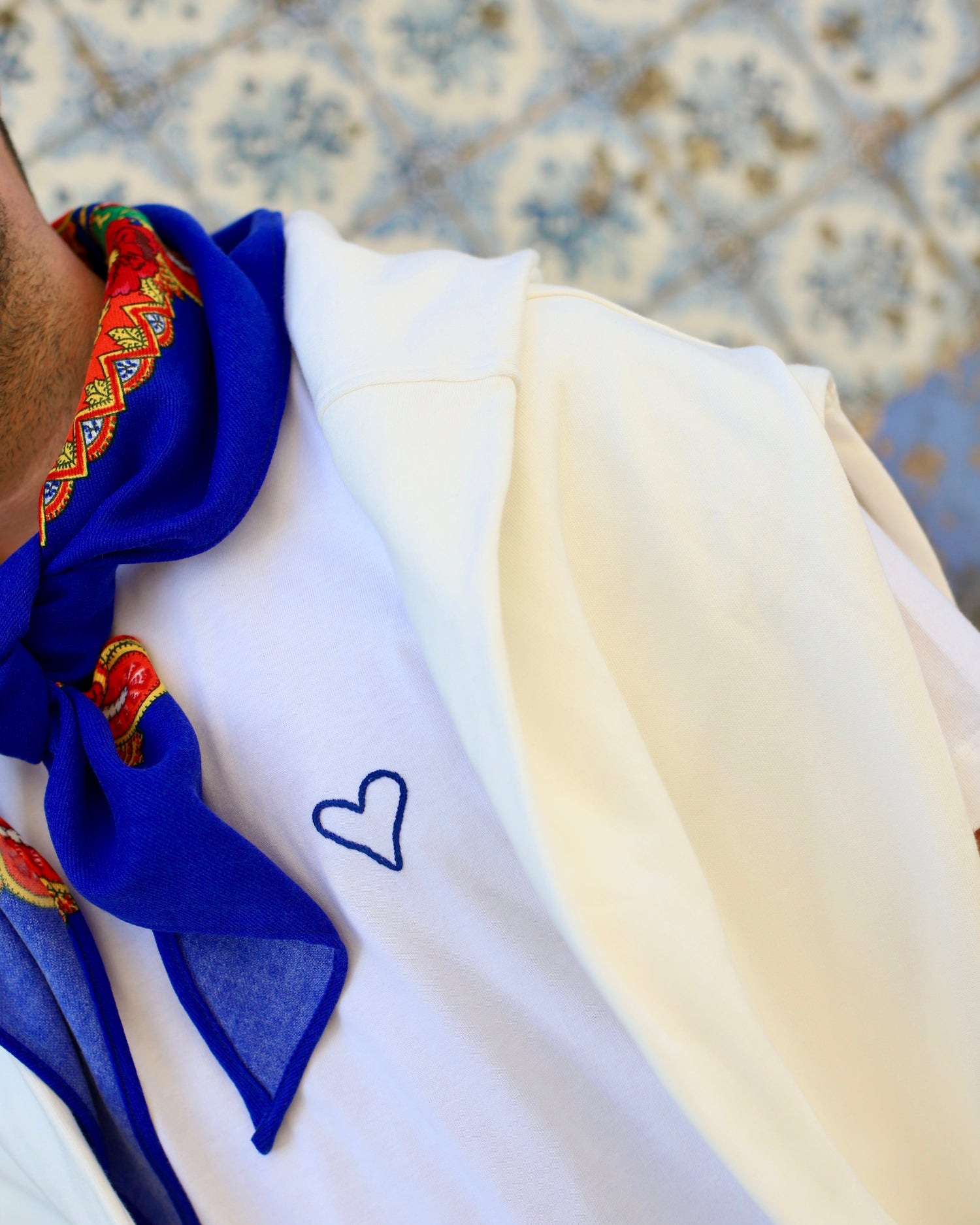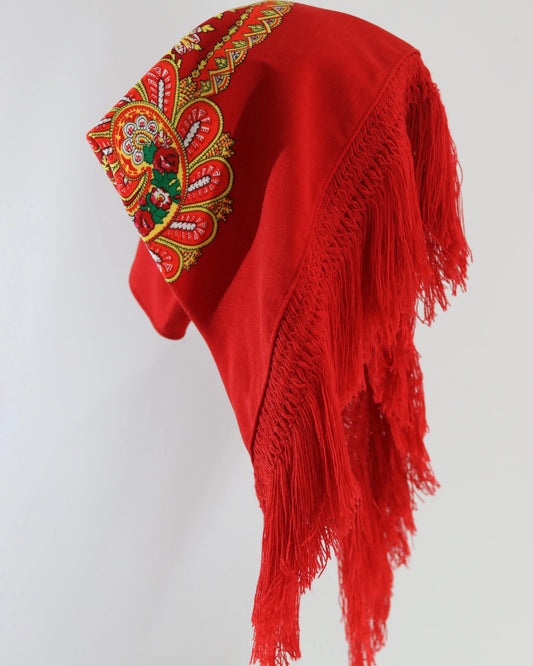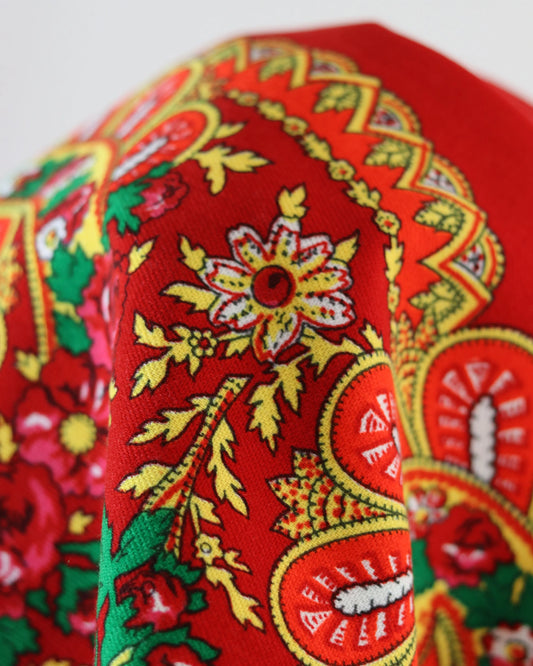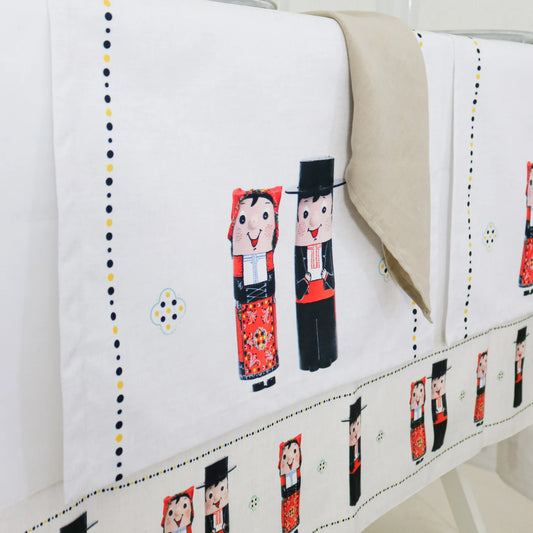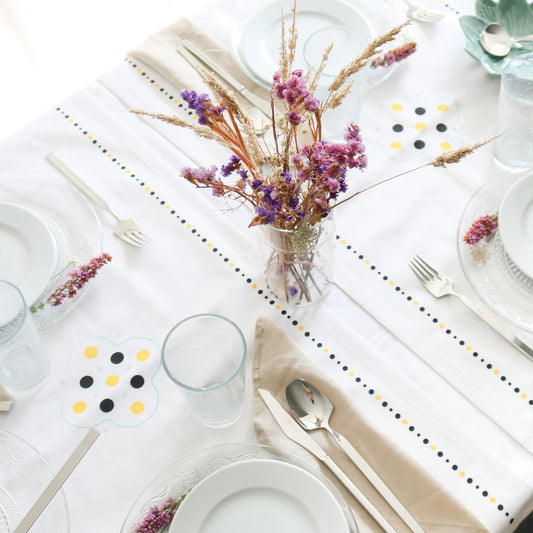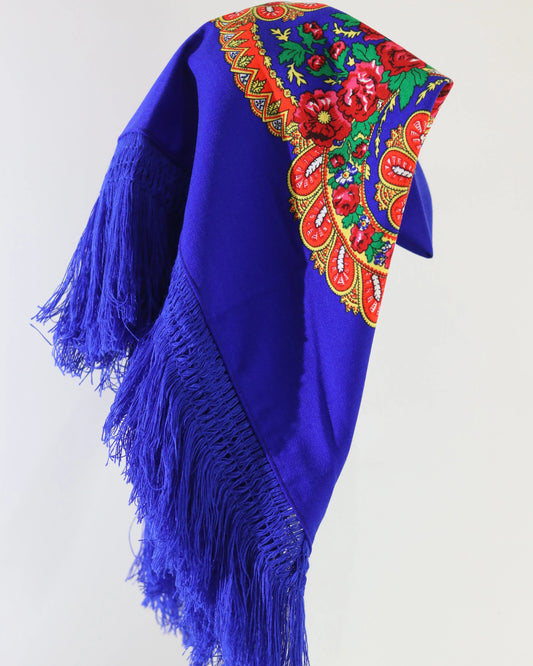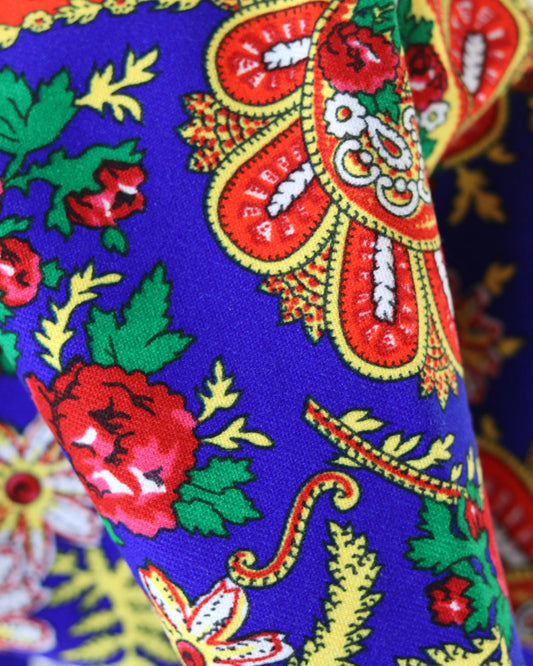Discover the meaning of colors and Vianesa embroidery
Anyone who observes a Vianesa costume during the Romaria d'Agonia (Romanization of Agony) first notices the shine of the gold and the movement of the skirts. Only then does the revelation come: each color, each flower, and each embroidered heart tell a story. Vianesa embroidery is not mere ornament. It is language. It is geography and biography woven together, a chromatic and symbolic code that spans generations in Alto Minho, especially in Viana do Castelo.
The art was born at home, in the hands of embroiderers who knew when to use bright red on girls' skirts, what type of carnation should go on a bride's apron, how to line ears of grain with grapes to wish for abundance. Nothing was left to chance. And to this day, when a young woman ties a scarf around her head, when she chooses the apron that best suits her story, the meaning remains.
Below is a guide to reading this living language that combines color, symbol, and technique with rare mastery.
Where does Viana embroidery come from?
The tradition flourished in Viana do Castelo and surrounding areas, in a region where everyday attire and party wear shared materials and tastes. Embroidery expanded from trousseaus and handkerchiefs to aprons, vests, skirts, and pockets, gaining aesthetic depth and social norms.
- Home workshops have become a local reference.
- The pilgrimages, especially the Agonia pilgrimage, served as a stage and a sieve of quality.
- The Costume Museum, cultural associations and folklore groups helped to establish models and technical documentation.
Over time, a visual lexicon has formed—flowers, hearts, ears of corn, grapes, bows, birds—and a set of favorite, vibrant colors that can be recognized from a distance.
The palette that tells stories
In Minho, color speaks volumes. In Viana embroidery, it speaks even louder. Red opens the party, blue soothes, green promises, yellow shelters the sun, white cleans, and black gathers. It's not a rigid guide, but continuities remain.
| Color | Main meaning | In which pieces does it appear most? | Occasions and nuances |
|---|---|---|---|
| Red | Youth, vitality, protection | Maiden skirts, apron details | Dance and pilgrimage, energy, affirmation |
| Blue | Fidelity, serenity, sea | Wedding skirts, scarves, ribbons | Adulthood, stability, devotion |
| Green | Hope, fertility, field | Embroidery of foliage, branches | Harvest, good omens, renewal |
| Yellow/Gold | Joy, abundance, light | Threads in embroidery and jewelry | Exuberance, fortune, welcome |
| White | Purity, honesty, linen | Shirts, cuffs, lace | Rites, engagement, cleansing of forms |
| Black | Mourning, modesty, withdrawal | Widow's skirts, shawls | Respect, gravity, silence |
| Rose | Tenderness, courtship | Small flowers on the apron | Delicate message, affection |
| Purple | Devotion, introspection | Discreet details | Restrained use, ceremonial tone |
Notice how yellow isn't limited to gold. Many aprons use yellow thread to create a shimmer that complements the cords and brooches, even when the piece is more subdued.
Dress Codes - Single, Married, Widowed
The interpretation of costumes begins with the skirts. The pattern varies by parish, family, and time, but some rules apply across the territory:
- Single - red skirt with braids, stripes, and lush embroidery. The color screams life and a desire to dance.
- Married - blue skirt, mature embroidery, more symmetrical composition. The ensemble seeks balance and calm.
- Widow - black skirt, sober apron and scarf, reduced and discreet motifs. Respect and memory.
The apron serves as the main canvas. It embroiders the house's message: ears of corn and grapes for abundance, carnations and ribbons for strength and commitment, the heart of Viana for love and faith. The pocket, often heart-shaped, reinforces the note of affection and belonging.
The headscarf also speaks volumes. A scarf with bold, passionate colors can signal courtship; a more subdued scarf can emphasize gravity or a period of mourning. The way the scarf is tied, the knots, and the ends convey wisdom passed down between women, often without words.
Reasons that spring from Minho
There's an entire garden in the Viana aprons. And in it, the symbols aren't arbitrary.
- Heart of Viana - love that is both earthly and divine, gratitude, promise, devotion. Clear connection to local jewelry.
- Carnations - firmness, persistence, consistency of character. At parties, they assert their presence.
- Roses - beauty and pride of the house. Some embroiderers prefer open roses to show abundance.
- Corn cobs - guaranteed bread, harvest, material security.
- Grapes and vines - joy, green wine, conviviality.
- Leaves and branches - life that is renewed, family that grows.
- Ties - union, commitment, silent marriage proposals.
- Stars and suns - protection, guidance, clarity.
- Doves and swallows - longing, return, message that arrives.
- Anchors - the sea of Viana, firm hope, connection to the men of the sea.
- Crosses - faith, promise fulfilled, memory of someone.
The charm of Viana embroidery lies in its composition. It's not just what you embroider, but how you embroider it. Larger motifs tend to occupy the center of the apron, flanked by branches and small flowers that create movement. The balance between fullness and emptiness is a workshop secret.
Threads, stitches and textures
Technique serves the story. And the story demands texture, relief, and saturated color. Three elements define the Viana hand: a full-bodied textile base, strong yarn, and a voluminous stitch.
- Bases - flannel, baize, twill, or linen, depending on the piece. Aprons and skirts require body, shirts and scarves require lightness.
- Yarns - wool for color and volume, cotton for detail, occasional silk for restrained shine.
- Needles and perforation - the design is transferred to the fabric with perforation and dyed chalk powder, or with hand-drawn lines by an experienced embroiderer.
Most used points:
- Chain stitch - lively, flexible contour, creates leaf vein and flower line.
- Back stitch - accuracy in contours and veins.
- Full point - petal with presence, dense heart, small areas of intense color.
- Drop point - quick shading and fills with light effect.
- Knot stitch - flower core, small relief that blinks when you look at it.
- Herringbone stitch and flower base - leaves and branches naturally.
The overlapping stitches create an almost sculptural effect. The result is visible on the apron: when the light hits it, the flower breaks free from the background, the heart vibrates, and the leaf gains nerves.
When colors meet gold
Viana's gold is a chapter in itself. But in costume, it's always a two-person conversation. The filigree illuminates the embroidery, and the embroidery responds with yellows and reds that enhance the shine.
Classic pieces:
- Heart of Viana in filigree
- Earrings and rings
- Shackles and chains
- Crosses, reliquaries, Viana beads
Layers of gold tell a story of family, savings, and pride. Some people coordinate the yellow thread in the embroidery to complement the main pendant. Others contrast the apron with deep blue to highlight the chains.
Reading a costume during the Romaria d'Agonia
A simple method to find your way around a party:
- Identify the color of the skirt - red vibrates youth; blue indicates marriage; black gathers.
- Looking at the apron - density of embroidery, central motifs and symmetry say a lot about intention and occasion.
- Look at the scarf - color range and way of tying.
- Note the pocket - shape, embroidery, decorative and practical function.
- Hear gold - if it shines in layers, a sign of event and belonging.
- Looking for color dialogue - see how the yellow of the line converses with the gold and how the green ties the flowers together.
This exercise transforms your perspective. You stop seeing only beauty and start reading the message.
The meaning of colors in action
Three short scenarios show how it all comes together:
- Summer party - girl in red skirt, apron with carnations, and grapes in a field of bright greens. Satin stitch on the petals, chain stitch on the branches, knot in the centers. A medium chain with a Viana heart matches the yellow thread that appeared on the flowers.
- Church exit - married woman in blue skirt, symmetrical leaf apron, central bow, and two discreet doves. Restrained palette: blue, dark green, white, and a few touches of ochre. Gold in fewer layers, matching scarf.
- Recent mourning—black skirt, nearly colorless apron, motifs reduced to leaves and a cross. Intentional absence of red, pink, and yellow. Silence is also embroidered.
From the workshop to the street today
Viana embroidery isn't confined to formal wear. Workshops and designers create contemporary pieces that maintain the same style: wool coats with small branches, bags with hearts and ears of wheat, linen scarves with doves. Innovation is evident in the scale of the motifs, unexpected backgrounds, and in dialogues with materials like burel, denim, or rustic silk.
Even when you change the shape, the color continues to encode. A coat with antique rose and dried green evokes autumn. A purse with bright red and yellow calls for a party. Embroiderers create chromatic variations within tradition, without losing the Viana style.
Quick guide to color combinations
- Red + yellow + green - celebration, vitality and generosity.
- Blue + white + gold - serenity with class, ceremonial tone.
- Black + purple + white - devotion and recollection.
- Pale pink + leaf green - courtship and delicacy.
- Wine + ochre + olive green - maturity, country sophistication.
A rule of thumb: when gold rises, a touch of yellow in the embroidery helps balance it out. When gold falls, blue and green take the lead.
How to choose meaningful motifs and colors
For those ordering a piece or creating a costume, it's worth considering the meanings. Here are some clues:
- Central motif - heart for love, ear of corn for abundance, anchor for connection to the sea.
- Secondary motives - branches and leaves provide continuity, ties reinforce commitment.
- Contrast - light petals on a dark background or vice versa, depending on whether the piece calls for presence or discretion.
- Rhythm - alternating large and small flowers creates movement and easy reading.
- Fabric listening - flannel accepts saturated color; linen calls for moderation and soft shade.
Care and longevity of parts
Embroidered pieces require attention. The goal is to preserve color, relief, and design.
- Store in a dry place, away from direct light.
- Place tissue paper between folds to protect the relief.
- Hand wash with cold water and mild soap, without wringing.
- Dry horizontally, away from heat.
- Iron inside out with a thin cloth, avoiding crushing the stitch.
- Repair small frays early, in a workshop accustomed to the Viana stitch.
Every care extends the life of a message you want to pass on.
The technical look that sustains beauty
Those who evaluate the quality of Viana embroidery look for cohesion between design, color, and stitch. Some signs of excellence:
- Consistency of tension in the yarn - uniform relief, without pulling.
- Wise choice of stitches - contour that breathes, filling without excessive heavy masses.
- Coherent palette - colors that dialogue with the base and the gold.
- Legible central motif - heart, flower or spike that can be recognized at first glance, even from afar.
- Clean finishes on the reverse - a sign of a trained hand and respect for the piece.
The technique isn't there to showcase gratuitous virtuosity. It serves the legibility of the symbol and the truth of the color.
Learning to embroider vianesa
Beginners can start with scarves and small bags. Three practical tips:
- Sketch the composition in light pencil and decide on the central motif before choosing the points.
- Testing the palette on a scrap of the same base, to see how the wool behaves.
- Work from the center to the edges, saving the final outline for last.
A swatch book with satin stitch petals, chain stitch leaves, and knotted cores helps maintain consistency between pieces.
The strength of a living heritage
They call Viana do Castelo the princess of Lima. In her attire, royalty is chromatic, and embroidery is the lingua franca. When a young woman dons a red skirt and ties up her scarf, she gives way to so many previous gestures. When someone chooses a blue apron with deep green leaves, she conveys a sense of serenity that the city recognizes.
Some see only celebration and glitter, others focus more on gold. Those who pay attention to colors and embroidery understand something intimate: an emotional map, a family geography, a harvest calendar, the sea breeze that arrives from the port. Each stitch connects a motif to a meaning. And that meaning continues to grow, piece by piece, hands teaching hands.



